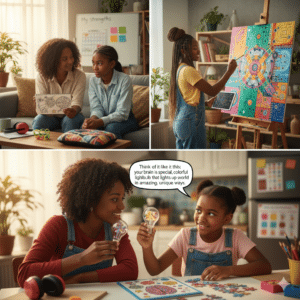The conversation around neurodiversity has grown in recent years, yet one area still widely misunderstood is the overlap of ADHD and Asutism in women. While ADHD (Attention Deficit Hyperactivity Disorder) and ASD (Autism Spectrum Disorder) are often viewed as separate conditions, many women live with traits of both. This dual experience is sometimes referred to as ADHD.
Here’s the issue: most diagnostic criteria were created based on how men present, leaving women misdiagnosed, underdiagnosed, or misunderstood. For parents raising daughters, sisters, or even supporting adult women, understanding this overlap is critical.
Let’s break down the science, the signs, the struggles, and most importantly the strategies to provide effective support.

When both coexist:
📌 Fact: Studies suggest nearly 30–50% of autistic individuals also meet criteria for ADHD, and women are particularly likely to experience this overlap.
Most of the research on ADHD and autism has historically focused on boys. The classic checklists were built around traits that are more obvious in males—like hyperactivity or overt social withdrawal. Women and girls often present differently: they may be more daydreamy, less disruptive, or better at hiding their difficulties. Because of this, clinicians sometimes miss the signs entirely. This diagnostic bias means many women go undiagnosed until adulthood, after years of feeling “different” without knowing why. To fix this, assessments need to be more inclusive, with tools that recognize gender differences in neurodiverse traits.
Masking is when women consciously or unconsciously cover up their struggles. For example, a woman with ADHD might write endless to-do lists to look “on top of things,” even though she feels scattered inside. A woman with autism might copy social behaviors—like smiling at the right time or rehearsing conversations—so she seems “normal.” While masking can help them get through school or work, it often comes at a high cost: exhaustion, burnout, and sometimes losing touch with who they really are. Over time, this effort to fit in can create deep anxiety and even identity confusion.
Girls and women don’t always show the “textbook” signs of ADHD and autism. Instead of running around the classroom, a girl with ADHD might look perfectly quiet while she’s doodling in her notebook or zoning out. Instead of withdrawing socially, a girl with autism might force herself into conversations, keeping up appearances while feeling completely drained. These subtler symptoms can be misleading: teachers see a “well-behaved” student, parents see a “responsible” daughter, but inside she’s struggling with focus, overwhelm, and sensory overload. This gap between external behavior and internal experience is one reason why so many women are overlooked.
Because women’s symptoms look different, doctors often mistake them for something else. Anxiety, depression, bipolar disorder, or borderline personality disorder are common mislabels. While it’s true that many women with ADHD and autism overlap also experience anxiety or mood challenges, these are usually secondary to the core neurodiverse traits. Without the right diagnosis, women spend years in therapy or on medication that only partly helps, leaving them frustrated and unsupported. Correct diagnosis matters—it unlocks tailored strategies, proper resources, and a sense of validation that can be life-changing.
Here’s a quick comparison of overlapping traits:
| Domain | How It Shows in Women with ADHD | How It Shows in Women with Autism | Overlap (AuDHD) |
| Attention | Easily distracted, forgetful | Hyperfocused on interests | Struggle balancing focus & attention |
| Social | Talkative but may interrupt | Struggle with small talk, social rules | Social confusion, exhaustion |
| Emotions | Impulsive reactions, mood swings | Difficulty expressing emotions | Emotional dysregulation, shutdowns |
| Sensory | Restlessness, fidgeting | Hypersensitive to lights, sounds | Sensory overwhelm + hyperactivity |
| Executive Function | Trouble organizing tasks | Difficulty planning routines | Procrastination, overwhelm, burnout |
When ADHD and autism occur together, the impact runs deeper than just “double the challenges.” The traits interact, often masking one another, which makes it harder for women to get recognized and supported. Instead of fitting into neat boxes, they find themselves constantly juggling conflicting needs—like craving structure but struggling to maintain it, or wanting social connection but burning out quickly. This overlap influences nearly every area of life: mental health, education, relationships, and career.
Women with both ADHD and autism are at higher risk for anxiety, depression, and burnout. Part of this comes from years of masking—forcing themselves to act “normal” in order to fit in. Over time, that pressure chips away at self-esteem. Many internalize a sense of failure when they can’t meet social or academic expectations, even though the real issue is lack of proper support. They may feel stuck in a cycle of trying harder, burning out, and blaming themselves, which only worsens their mental health.
In school, these girls are often bright but misunderstood. They may know the answers but struggle to get assignments done on time. Teachers might see a distracted or disorganized student and label her as “lazy” instead of asking why she’s struggling. Sensory sensitivities can also make classrooms overwhelming—bright lights, constant noise, or crowded halls can drain their focus before they even sit down to learn. Without tailored support, their potential is overlooked, and the gap between ability and performance grows wider.
Navigating friendships and romantic relationships can be especially tough. Difficulties with reading social cues or maintaining boundaries may lead to misunderstandings or unhealthy dynamics. In intimate relationships, sensory sensitivities—like discomfort with touch or overstimulation—can cause strain if not openly discussed. At the same time, their intense honesty and loyalty are incredible strengths, but without partners or friends who understand their needs, these qualities can be misread as “too much” or “too distant.” Social exhaustion is common, leaving women torn between wanting connection and needing solitude.
Workplaces add another layer of challenge. Meeting deadlines, juggling multiple tasks, and sitting through back-to-back meetings can be overwhelming for ADHD traits. Add autism into the mix, and sensory-heavy environments—bright lights, constant chatter, office politics—can become unbearable. Many women excel in roles that allow them to hyperfocus, think creatively, or work independently, but those strengths are often overshadowed by struggles with organization or workplace norms. Without accommodations or supportive leadership, their talents risk being undervalued, which contributes to job instability or stalled career growth.

Women who experience both ADHD and autism often face unique challenges that are overlooked because their symptoms don’t always match the “classic” presentations. They may appear high-functioning on the outside but feel overwhelmed inside. Support means recognizing these layers, giving them space to be themselves, and ensuring they don’t fall through the cracks of either diagnosis.
Getting the right diagnosis is the first step. Too often, women are misdiagnosed with anxiety or depression without anyone looking deeper. A comprehensive assessment should include developmental history, behavioral observations, and input from family or close friends. Look for clinicians who have specific experience with neurodiverse women, since their symptoms often present differently than men. Make sure the evaluation doesn’t focus solely on ADHD or autism—both need to be considered side by side to avoid partial answers that leave women unsupported.
There’s no one-size-fits-all solution, so strategies need to be tailored. For ADHD-related struggles, planners, digital reminders, and task management apps can help manage forgetfulness and disorganization. For autistic traits, creating calm, sensory-friendly environments makes a huge difference—think noise-canceling headphones, soft lighting, or quiet corners at home. It’s also important to plan downtime after demanding social events so they can recharge without guilt. A mix of structure, flexibility, and self-compassion is often the best recipe.
Instead of focusing only on the difficulties, shift the lens to their strengths. Many women with ADHD and autism overlap show incredible creativity, strong pattern recognition, deep empathy, or a unique ability to hyperfocus on things they love. These qualities can be turned into personal and professional strengths. Celebrate small wins and highlight resilience, not just the hurdles. This change in perspective boosts confidence and helps women see themselves as capable rather than “broken.”
Parenting a girl with both ADHD and autism requires patience and advocacy. Start by validating her feelings—when she says something is hard, respond with belief instead of dismissal. Break down tasks into smaller, clear steps so she doesn’t feel overwhelmed. In school, fight for accommodations such as quiet testing spaces, extra time, or sensory breaks. Just as important, teach her to speak up for her needs as she grows older. Self-advocacy will empower her to navigate friendships, academics, and eventually, the workplace with confidence.

Many women don’t receive a diagnosis until adulthood. They often describe their childhood as “walking a tightrope”—constantly trying to appear normal but feeling exhausted.
A mother might recall her daughter being the “perfect student” at school but melting down at home. That’s masking in action.
External resource: CHADD.org provides detailed guidance for families navigating ADHD and autism overlaps.
If you or someone you love is struggling with ADHD or autism and needs extra support, don’t hesitate to reach out for help. You can contact the NAMI HelpLine at 1-800-950-6264 or email info@nami.org to ask questions, get guidance, or connect with resources related to autism spectrum disorder (ASD) and ADHD.
Q1: Can ADHD and autism occur together?
Yes. Research confirms significant overlap, and it’s more common than once believed.
Q2: Why are women diagnosed later than men?
Because diagnostic systems are male-centered, and women often mask their symptoms.
Q3: What’s the difference between ADHD hyperfocus and autism special interests?
Hyperfocus is temporary and often task-driven. Special interests are long-term, deep, and emotionally grounding.
Q4: How can I support my teenage daughter with overlapping traits?
Provide structure, validate her struggles, and connect with professionals who understand AuDHD in girls.
Understanding the ADHD and autism overlap in women is more than medical knowledge—it’s a call for empathy. Parents who recognize these signs early give their daughters a chance to embrace who they are, instead of fighting to “be normal.”
This overlap doesn’t mean brokenness. It means a different wiring, a different rhythm. With the right support, women with ADHD and autism can thrive—not in spite of their differences, but because of them.